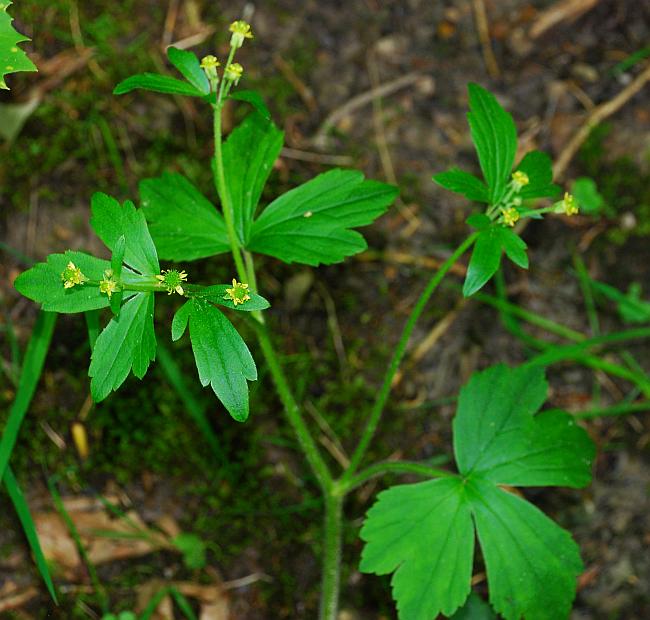Ranunculus recurvatus Poir.
Hooked Crowfoot

Native
CC = 5
CW = -3
MOC = 52
© SRTurner
Ranunculus recurvatus Poir.Hooked Crowfoot | |
 |
Native CC = 5 CW = -3 MOC = 52 |
© SRTurner |
|
Family - Ranunculaceae Habit - Perennial forb from fleshy roots and a bulbous-thickened, cormlike base. Roots not tuberous. Stems - Ascending to erect, to 40 cm, single from base, branching, not rooting at the lower nodes, moderately to densely pubescent with fine, spreading hairs, hollow (especially at the apex).
Leaves - Alternate and basal, petiolate. Basal leaves with petiole to 15 cm long, the petioles hirsute, sheathing at the base, the blade 2.0-7.5 cm long, 3.0-11.6 cm wide, ovate to kidney-shaped, simple, moderately to deeply 3-lobed, the base shallowly to deeply cordate, the lobes oblong to rhombic, sometimes again 2-or 3-lobed, the lobes bluntly to sharply pointed at the tip, the margins otherwise scalloped or finely and mostly bluntly toothed. Stem leaves relatively few, similar to the basal leaves, but with shorter petioles (the uppermost often sessile or nearly so) and less divided blades.
Inflorescence - Single axillary flowers. Peduncles antrorse-pubescent to glabrous, short in flower, quickly elongating in fruit, to 3 cm. Flowers - Sepals 5, 3-6 mm long, reflexed from at or near the base (lacking a transverse fold), more or less plane. Petals 5, 3-5 mm long, 1-2 mm wide, lanceolate to broadly oblong-oblanceolate, about as long as or slightly shorter than the sepals, glabrous, yellow. Style present. Stamens numerous, from base of pistil. Filaments whitish, glabrous, 2-3 mm long. Receptacle with straight white hairs.
Fruits - Fruiting heads globose, 5-7 mm long at maturity. Achenes 1.6-2.2 mm long, flattened, the dorsal margin strongly keeled but usually unwinged, the wall thick, the lateral faces minutely pitted (appearing smooth except under strong magnification), glabrous, the beak flattened, lanceolate, hooked. Beaks of achenes 1.0-1.2 mm long.
Flowering - April - July. Habitat - Forests, margins of small streams, pond margins, swamps, fens, ledges of bluffs, moist roadsides. Origin - Native to the U.S. Lookalikes - Distantly, R. abortivus and R. micranthus. Other info. - This species occurs in Missouri mostly south of the Missouri River. Missouri lies near the western edge of the plant's natural range, which extends throughout the eastern half of the continental U.S. and into Canada. The plant is easy to identify by a combination of habitat, large lobed leaves, and small, pale yellow flowers. The hooked tips of the fruits provide confirmation of the identity. The plant seems to prefer moist, shaded areas near small creeks. Photographs taken in Brown Summit, NC., 4-27-02 (DETenaglia); also at Klondike County Park, St. Charles County, MO, 5-9-2009, Matson Hill County Park, St. Charles County, MO, 4-29-2015, and Don Robinson State Park, Jefferson County, MO, 5-22-2017 (SRTurner). |